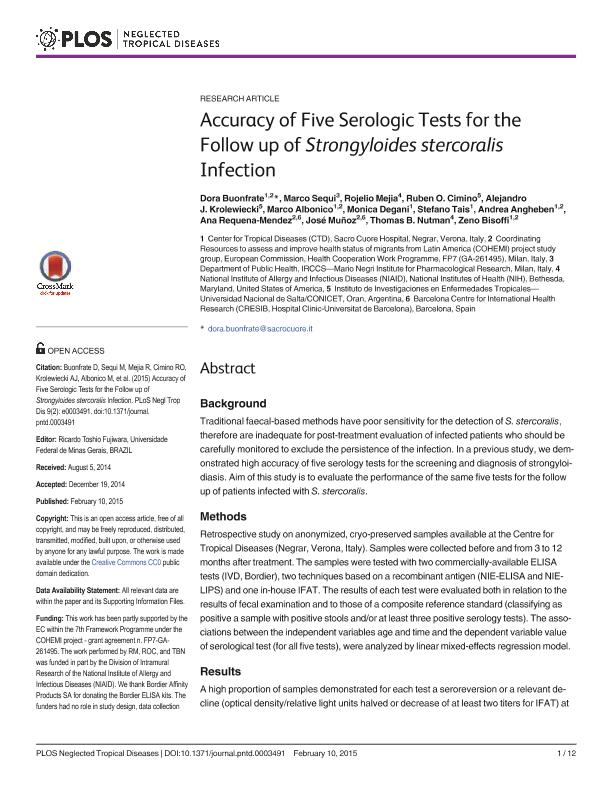Mostrar el registro sencillo del ítem
dc.contributor.author
Buonfrate, Dora
dc.contributor.author
Sequi, Marco
dc.contributor.author
Mejia, Rojelio
dc.contributor.author
Cimino, Ruben Oscar
dc.contributor.author
Krolewiecki, Alejandro Javier

dc.contributor.author
Albonico, Marco
dc.contributor.author
Degani, Monica
dc.contributor.author
Tais, Stefano
dc.contributor.author
Angheben, Andrea
dc.contributor.author
Requena Mendez, Ana
dc.contributor.author
Muñoz, Jose
dc.contributor.author
Nutman, Thomas
dc.contributor.author
Bisoffi, Zeno
dc.date.available
2016-08-08T15:57:48Z
dc.date.issued
2015-02-10
dc.identifier.citation
Buonfrate, Dora; Sequi, Marco; Mejia, Rojelio; Cimino, Ruben Oscar; Krolewiecki, Alejandro Javier; et al.; Accuracy of Five Serologic Tests for the Follow up of Strongyloides stercoralis Infection; Public Library Of Science; Neglected Tropical Diseases; 9; 2; 10-2-2015; e0003491-e0003491
dc.identifier.issn
1935-2735
dc.identifier.uri
http://hdl.handle.net/11336/6988
dc.description.abstract
Background
Traditional faecal-based methods have poor sensitivity for the detection of S. stercoralis, therefore are inadequate for post-treatment evaluation of infected patients who should be carefully monitored to exclude the persistence of the infection. In a previous study, we demonstrated high accuracy of five serology tests for the screening and diagnosis of strongyloidiasis. Aim of this study is to evaluate the performance of the same five tests for the follow up of patients infected with S. stercoralis.
Methods
Retrospective study on anonymized, cryo-preserved samples available at the Centre for Tropical Diseases (Negrar, Verona, Italy). Samples were collected before and from 3 to 12 months after treatment. The samples were tested with two commercially-available ELISA tests (IVD, Bordier), two techniques based on a recombinant antigen (NIE-ELISA and NIE-LIPS) and one in-house IFAT. The results of each test were evaluated both in relation to the results of fecal examination and to those of a composite reference standard (classifying as positive a sample with positive stools and/or at least three positive serology tests). The associations between the independent variables age and time and the dependent variable value of serological test (for all five tests), were analyzed by linear mixed-effects regression model.
Results
A high proportion of samples demonstrated for each test a seroreversion or a relevant decline (optical density/relative light units halved or decrease of at least two titers for IFAT) at follow up, results confirmed by the linear mixed effects model that showed a trend to seroreversion over time for all tests. In particular, IVD-ELISA (almost 90% samples demonstrated relevant decline) and IFAT (almost 87%) had the best performance. Considering only samples with a complete negativization, NIE-ELISA showed the best performance (72.5% seroreversion).
Conclusions
Serology is useful for the follow up of patients infected with S. stercoralis and determining test of cure
dc.format
application/pdf
dc.language.iso
eng
dc.publisher
Public Library Of Science

dc.rights
info:eu-repo/semantics/openAccess
dc.rights.uri
https://creativecommons.org/licenses/by/2.5/ar/
dc.subject
Strongyloides Stercoralis
dc.subject
Serología
dc.subject
Elisa
dc.subject
Geohelmintos
dc.subject.classification
Parasitología

dc.subject.classification
Ciencias de la Salud

dc.subject.classification
CIENCIAS MÉDICAS Y DE LA SALUD

dc.title
Accuracy of Five Serologic Tests for the Follow up of Strongyloides stercoralis Infection
dc.type
info:eu-repo/semantics/article
dc.type
info:ar-repo/semantics/artículo
dc.type
info:eu-repo/semantics/publishedVersion
dc.date.updated
2016-08-04T18:18:19Z
dc.journal.volume
9
dc.journal.number
2
dc.journal.pagination
e0003491-e0003491
dc.journal.pais
Estados Unidos

dc.journal.ciudad
San Francisco
dc.description.fil
Fil: Buonfrate, Dora. Sacro Cuore Hospital. Center for Tropical Diseases; Italia. Coordinating resources to assess and improve Health status of Migrants from Latin America; Italia
dc.description.fil
Fil: Sequi, Marco. Mario Negri Institute for Pharmacological Research. Department of Public Health; Italia
dc.description.fil
Fil: Mejia, Rojelio. Public Health Service. National Institute Of Health; Estados Unidos
dc.description.fil
Fil: Cimino, Ruben Oscar. Universidad Nacional de Salta. Sede Regional Oran. Instituto de Investigación de Enfermedades Tropicales; Argentina. Consejo Nacional de Investigaciones Científicas y Técnicas; Argentina
dc.description.fil
Fil: Krolewiecki, Alejandro Javier. Consejo Nacional de Investigaciones Científicas y Técnicas. Centro Científico Tecnológico Salta. Instituto de Patología Experimental; Argentina. Universidad Nacional de Salta. Sede Regional Oran. Instituto de Investigación de Enfermedades Tropicales; Argentina
dc.description.fil
Fil: Albonico, Marco. Sacro Cuore Hospital. Center for Tropical Diseases; Italia
dc.description.fil
Fil: Degani, Monica. Sacro Cuore Hospital. Center for Tropical Diseases; Italia
dc.description.fil
Fil: Tais, Stefano. Sacro Cuore Hospital. Center for Tropical Diseases; Italia
dc.description.fil
Fil: Angheben, Andrea. Sacro Cuore Hospital. Center for Tropical Diseases; Italia. Coordinating resources to assess and improve Health status of Migrants from Latin America; Italia
dc.description.fil
Fil: Requena Mendez, Ana. Coordinating resources to assess and improve Health status of Migrants from Latin America; Italia. Centro de Investigación en Salud Internacional de Barcelona; España
dc.description.fil
Fil: Muñoz, Jose. Coordinating resources to assess and improve Health status of Migrants from Latin America; Italia. Centro de Investigación en Salud Internacional de Barcelona; España
dc.description.fil
Fil: Nutman, Thomas. Public Health Service. National Institute Of Health; Estados Unidos
dc.description.fil
Fil: Bisoffi, Zeno. Sacro Cuore Hospital. Center for Tropical Diseases; Italia. Coordinating resources to assess and improve Health status of Migrants from Latin America; Italia
dc.journal.title
Neglected Tropical Diseases

dc.relation.alternativeid
info:eu-repo/semantics/altIdentifier/doi/10.1371/journal.pntd.0003491
dc.relation.alternativeid
info:eu-repo/semantics/altIdentifier/url/http://journals.plos.org/plosntds/article?id=10.1371/journal.pntd.0003491
dc.relation.alternativeid
info:eu-repo/semantics/altIdentifier/doi/http://dx.doi.org/10.1371/journal.pntd.0003491
dc.relation.alternativeid
info:eu-repo/semantics/altIdentifier/url/http://www.ncbi.nlm.nih.gov/pmc/articles/PMC4323101/
dc.relation.alternativeid
info:eu-repo/semantics/altIdentifier/pmid/PMC4323101
Archivos asociados
